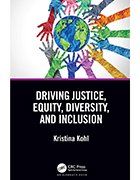Justice, equity, diversity and inclusion: Essentials for businesses
As the demographics in the modern workforce change, so, too, do the demands.
A diverse and inclusive culture in the workplace is important for organizations today.
Modern job seekers want to work for companies that value and practice diversity, which is especially true of Generation Z recruits. Companies must create a level playing field, remove systemic barriers and provide equal access for all.
"There are changing demographics and changing demands from Gen Z," said Kristina Kohl, managing principal of HRComputes and author of Driving Justice, Equity, Diversity, and Inclusion. "Their expectation when they to go work for a business is it won't be a biased organization. If it is, they don't want to work there. [Businesses] need to figure out what [their] organization represents and why people would want to work for [them]."
Businesses must practice J.E.D.I., which stands for the principles of justice, equity, diversity and inclusion. A successful J.E.D.I. initiative addresses diversity from the top down, starting with the leadership team. A diversity of backgrounds, education and experience is fertile ground for new ideas. This is why organizations with leadership diversity also show improvement in the bottom line, Kohl said.
"As a society we've said a lot of things about diversity, equity and inclusion. Gen Z expects alignment between what we're saying and what we're doing. They expect authenticity," Kohl said.
The following excerpt from Chapter 7 of Driving Justice, Equity, Diversity, and Inclusion looks at how organizations that create a culture of belonging shows employees that they are welcome, valued and supported.
 Purchase your copy of
Purchase your copy of
Driving Justice, Equity,
Diversity, and Inclusion
by clicking on the image
above.
Creating a Culture of Belonging
Creating a culture of belonging is crucial to ensuring that your workforce believes that they are welcome, supported, and valued by your organization. Driving a J.E.D.I. transformation requires leadership to look deeply into their own culture and to understand who sets the standards for norms, values, attitudes, and beliefs. Leadership must ask themselves if they expect employees and other stakeholders to assimilate into their dominant culture or if they are building an equitable culture that values and supports a variety of perspectives, identities, cultures, and styles. So often, leaders focus their strategy on increasing the diversity representation of their talent pool, but they don't fully appreciate the importance of creating a culture where diversity is appreciated, valued, and rewarded. Creating a culture of belonging means changing how organizations operate including board representation, leadership competencies, leadership development, recruiting practices, supplier practices, talent development practices, and team norms. Transforming into a J.E.D.I. organization requires drilling deep into organizational systems to understand root causes and systemic barriers built into the operating foundation.
 Kristina Kohl
Kristina Kohl
7.1 Leadership Competencies for Belonging
Creating a culture of belonging is different from creating an inclusive culture. Inviting someone and including them implies that the person is joining an already existing group with its own culture. Often this is exemplified by the dominant culture of an organization, and employees must adapt to the organizational culture in order to be accepted, valued, and promoted. It implies that the employee is joining an existing work environment with work structures, team dynamics, and policies based on a particular cultural paradigm. Inclusion assumes that the new employee will adapt to the existing culture. In reality, creating a diverse workforce means that the work environment and work structures need to change in order to allow for different work requirements, structures, and practices. It requires establishing a culture where a variety of perspectives, experiences, styles, and backgrounds are valued and supported. Policies, practices, and processes need to be evaluated and redesigned to support a culture of belonging. While reasonable accommodation, modification, or adjustment of the work environment, may be the most visible of these adaptations, it is certainly not the only one. Team dynamics require reevaluation so that the loudest voice doesn't dictate decisions and that all team members feel comfortable contributing. Working parents, especially women, may require flexible work arrangements. Culturally diverse workers may require different accommodation for different holiday schedules. Creating a culture of belonging means welcoming and celebrating differences. An organization's culture and policies must reflect the diverse needs of its workforce, customers, and community.
The need to create a culture of belonging goes even deeper. It requires looking at what behaviors and contributions are valued by an organization and its leadership. Are certain university degrees valued over others? Do you require new hires to have experience with certain organizations? Valuing certain degrees or work experiences in the recruitment process and hiring based on those criteria create a culture with affinity bias. In effect, the process values hiring people that are like the existing workforce and leadership over others that have the required skills but reflect a different education background or work experience. Internally, there are biases for pathways to promotion and leadership as well. Often, the leadership path requires experience with departments or functions within the organization. Consider the following questions to evaluate your organization:
- Within the organization, are underrepresented groups more predominately represented in a certain division?
- If so, is this division's contribution to the organization valued in the same way as a predominately White division?
- Which divisions serve as the talent pipeline training ground for the leadership track?
- What has been the career path for your existing leadership team?
- How might the organization need to redesign its leadership development track to promote a culture of belonging?
As organizations seek to promote diversity, equity, and inclusion (DEI), we see that within organizations, there is a great deal of variance in terms of roles and responsibilities and perceived value across the organization. In order to retain a diverse workforce, an organization must create a culture of belonging that includes career development and advancement opportunities that reflect valuing workforce diversity. In order to manage, develop, and effectively engage a diverse workforce, new skills and competencies need to be developed for leaders and managers. To drive impact, we suggest moving from training to capacity building. In addition to offering training, educate on discrimination, fairness, access, and legitimacy, and focus on building leadership competencies to improve people management at the individual, team, department, and organizational level.
In order to instill diversity of identity, thought, and experience within an organization, consider your organization's board level diversity representation. Role models at the board level are crucial to ensure that employees, customers, and communities feel that there is someone at the board level with whom they identify. Figure 7.1 highlights performing a GAP analysis of the current board's diversity representation and comparing that to the organization's J.E.D.I. mission and vision.
As part of the process, consider the ecosystem in which your organization operates including employees, customers, suppliers, and communities.
- What is the representation of these key stakeholder groups?
- How does your board representation align with the diversity of identity, thought, and experience of these key stakeholders?
- What are the gaps between the representation in the current slate of board members and the organization's board representation goals?



